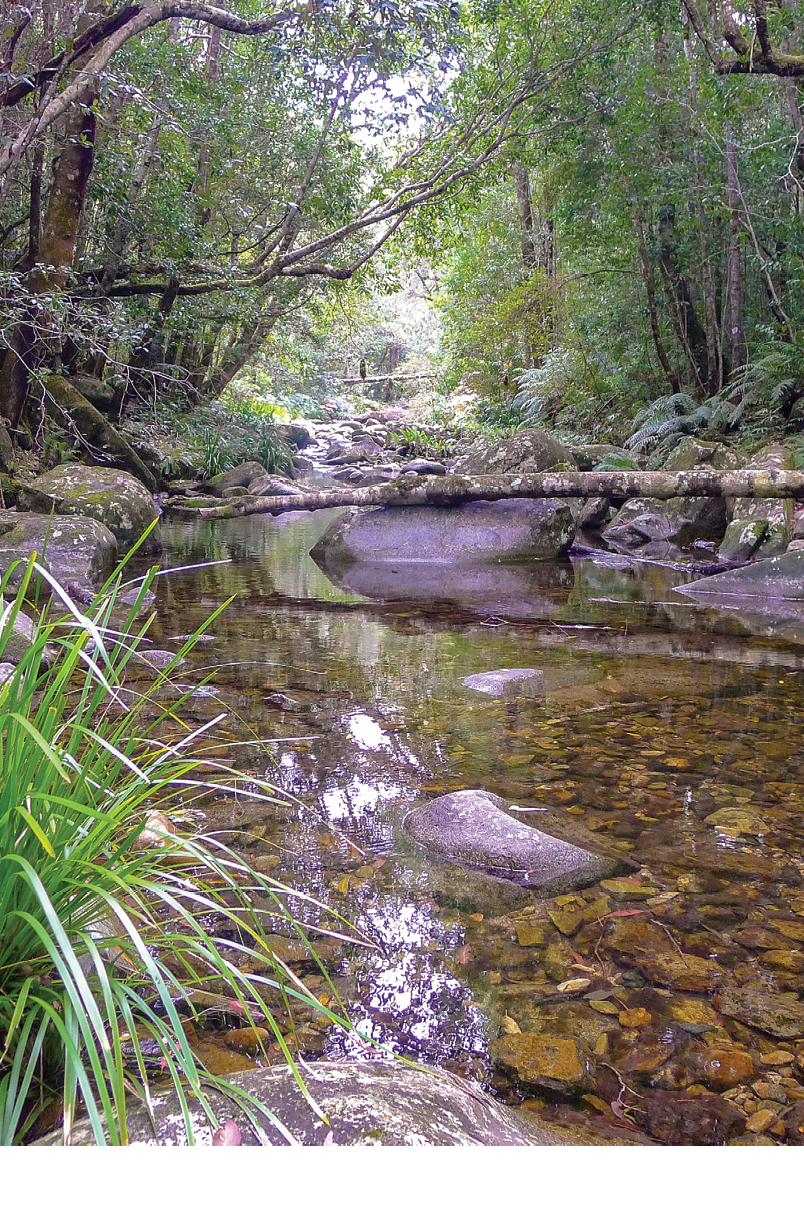


The coronavirus has forced us to think local and be agile. The Gibraltar Range and Washpool National Parks in northern NSW offer a variety of outdoors options that are "social distancing compliant" – and flexible to boot. And they will be there post-virus.
Coombadjha Creek adjacent to the Washpool WalkAll uncredited pictures by Craig N Pearce

Gibraltar and Washpool
Craig N Pearce

12 | BWA February 2021
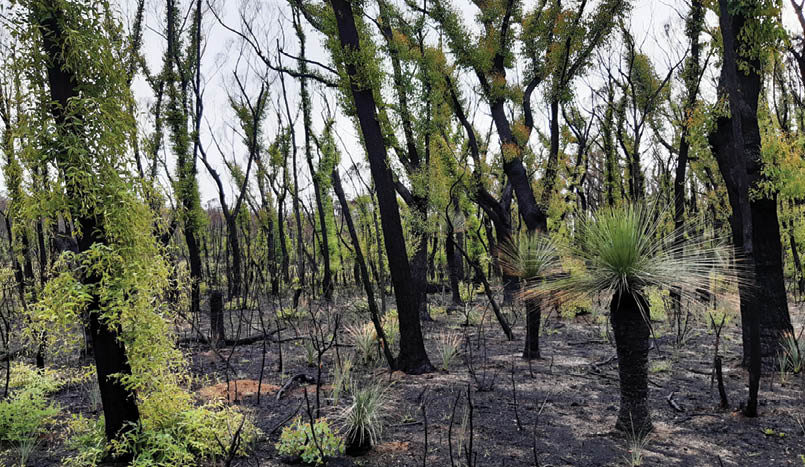

Early stages of recovery Koenraad Dijkstra
Crowned by a misty nimbus across its precipice, Dandahra Falls presented itself in sombre, epic glory. Threads of fog trailed over the abyss. Water poured from a gap between the trees, plummeting 130 metres down a near vertical granite cliff face. Its fall was punctuated mid-way by a massive pool. Tantalising. Beckoning. But out of reach to all but abseilers. From the pool, water gushed into the gully’s depths, unseeable, yet mysteriously audible.
“With bated breath and whispering humbleness …”, Shakespeare wrote. Not about these absorbing falls, admittedly, but it’s an apt phrase for a sight that pins you back in reverence. A formidable – almost bald – cliff face framed the scene. Outcrops of vegetation struggled to maintain a foothold. Thick bush and boulders like monuments crowded around. The fog stealthily closed in. Everything was utterly primal.
Like most of the features encountered over four days of traversing the Gibraltar-Washpool World Heritage Walk (WHW), located within the Gibraltar Range and Washpool National Parks in northern NSW, this was a moment experienced with only the breeze, silence and nature – sometimes somnolent, sometimes agitated – for company.
But that was before; before the crushing devastation of the summer of 2019-20’s bushfires; before coronavirus; and before that word "community" took on the weight it now possesses.
What now, with wilderness?Koenraad Dijkstra is a NSW National Parks and Wildlife Service ranger with 10 years’ experience of the area. He told me that, incredibly, nearly 100% of both the Gibraltar Range and Washpool National Parks were burnt by the fires. There is also the increasing dryness of the parks, thanks to you-know-what, which is making them more vulnerable to fire over the longer term.
“In the past we were able to do hazard reduction burns in August and September, but there’s no way we can do that now,” said Koen. “We have to do it earlier in the season or late autumn, which the local landowners agree with. It’s just too risky late spring or summer if we lose control or hazard reduction fires re-ignite.”
The rainforest elements of the parks were the hardest hit by the fires. “In Washpool we have the largest continuous rainforest area in NSW,” continued Koen. “All the wet forests and edges of the rainforests burnt heavily. It will take a while to recover, if it ever does.
BWA February 2021 | 13


People fought hard to protect the rainforest area over the years, but these trees are not adapted to fire. It’s been reduced and I anticipate it will shrink further.”
Observations like this are difficult to stomach. Rainforest patches here are jewels in a necklace of remnant rainforests trailing down the eastern edge of Australia, from Main Range National Park in the north to Barrington Tops National Park in the south. However, the largest portion of Gondwanan rainforests is in Tasmania’s Tarkine wilderness). This is the world’s most extensive area of subtropical rainforest and, collectively, they are a World Heritage Site, providing a glimpse of our planet from millions of years ago.
There are many more unique and precious elements to these parks. They include the largest remaining stand of coachwood-dominated warm temperate rainforest in Australia; and a mosaic of eucalypt and rainforest communities. Most of the parks – including sections through which the WHW passes – are a declared wilderness.
Koen is upbeat, however. “Because we’ve had so much rain the vegetation has been recovering like crazy. There is lots of epicormic (growing from a previously dormant bud on the tree) growth, lots of colour and lots of healthy plants. The spring flowering seasons should be really good. I can guarantee the Christmas bells will go berserk.
“We have lost a lot of small mammals and they will take longer to recover. But I have been surprised by how many red-necked pademelons, bandicoots, brush-tailed possums and parma wallabies we’ve seen. The wallabies were thought to be extinct back in the sixties, but then some were found in the eighties and they are now – or were – pretty common at Mulligans Hut.”
Despite the fire, Koen said the views from the higher points on the walk are the same, “just a bit more black and brighter greens from regrowth in the palette”. And precious sections like the rainforest parts of Washpool Walk diversion, through luxuriant rainforest, came through unscathed.
Varied impact of fireKoenraad Dijkstra
14 | BWA February 2021
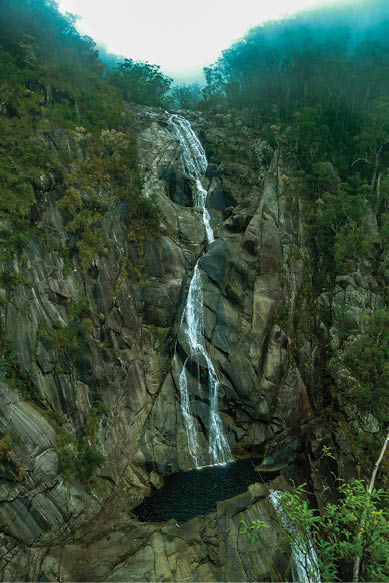
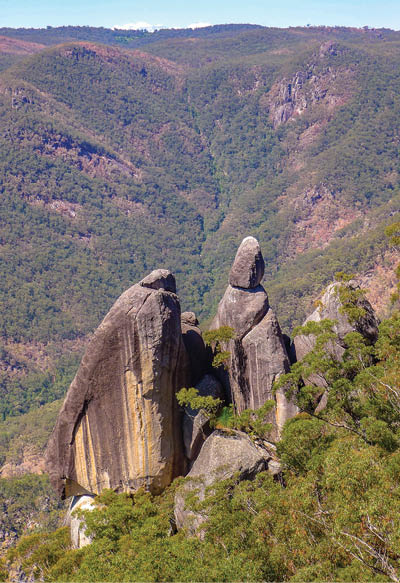
Dandahra Falls
World Heritage Walk: A primerDandahra Falls is, perhaps, the WHW’s signature experience. This is especially so when you consider the almost viscous wet eucalypt and rainforest tramped through to get there (it’s, um, sort of off-track … but easy enough to get to for most), and the other nearby water-wonder experiences you can pack into the exploration. For me, it was a magical and misty fairyland expedition that included Murrumbooee and Barra Nulla Cascades. As opposed to other blue skied days, this one was pervaded by a haunting, claustrophobic, gothic atmosphere.
But while it sounds less glamorous on paper, it is diversity itself that is the heart of the walk’s come-hither beauty.
A proliferation of wildflowers; an abundance of crazily diverting granite conglomerations; ravishing views (some hard fought for); reluctantly revealed pools, waterfalls and cascades; the contrasting verdant botanical environments; the heritage of the Bundjalung, Gumbaynggirr and Ngoorabul peoples who
once using these areas for ceremonies when travelling between the coast and tablelands; and its grazing, woodcutting, mining and grand, failed hydro-electric scheme past.
The walk’s story is a confluence of all these elements; another gem in our invaluable collection of Australian nature experiences.
High hopes and flowering intentHither granite, I found, came views. The first of these granite = distance = perspective triangulations came soon after beginning the WHW. The Needles is a modern art conurbation of six granite pillars, engaged in aspirational skyscrapering from a steep hillside dropping swiftly into Little Dandahra Creek. Its lookout reveals expanses of hills and valleys racing away into distant open country.
The Needles digression proved typical of the WHW’s side-trip rewards. On it, I discovered the first of many Gibraltar waratahs (another signature characteristic of the walk), glowing fire-red in the green. Also encountered were grass trees and New England blackbutt,
The Needles
BWA February 2021 | 15
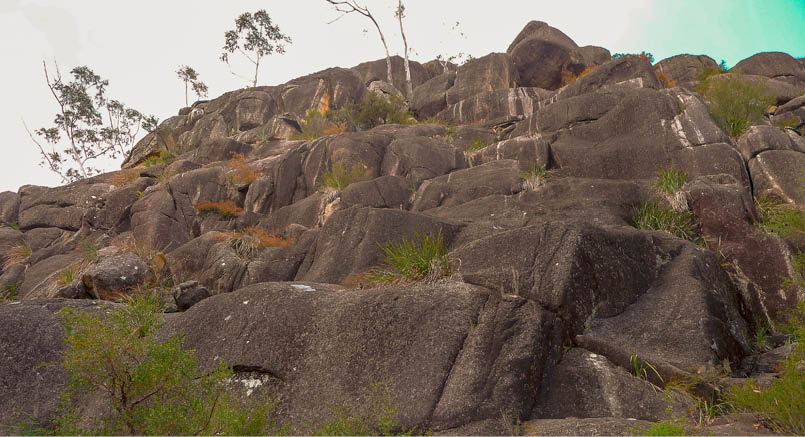
hakeas and banksias. The weaving walk occurred partially through thickly vegetated foliage tunnels (no wonder considering the rich, red soil from which it emerged), a cool blessing on an already warming day.
As I continued, the day shook itself awake and the track unfurled, sometimes through vaulted undergrowth ceilings and sometimes through open forest, an industrial thrum of cicadas surged and subsided as they did violence to themselves, creating the archetypal Australian soundtrack.
Other "high" points (as in literally possessing height) of the walk were The Haystack and Dandahra Crags. The former was heralded by a massive field of blunt-leaf heath wildflowers. The juxtaposition of the flowers, the bush on the surrounding slopes and granite mushrooming out of the earth was spellbinding.
The scramble up the Haystack, initially bashing through scrub, then past native holly and rare pink rock orchids, was a lark. And that’s before the wind just about kited me off my feet. It’s a gnarly plateau up top, where you can feast on 360-degree views. Cracked dinosaur egg-like granite conglomerations are randomly scattered. Old Man Hat is south-west and the Demon Fault is north-
west while, in the foreground, granite blisters proliferate. Another day, another act in the World Heritage drama.
Dandahra Crags provided a similar experience. Sprawling views unfurled over folds of bush-draped hills, across and over Cooraldooral Creek valley. More giant boulders balanced precariously. There were also views back over the tors of Cardinals Cap and The Mistake, and one of the walk’s trademark open fields of button grass. It grows in sedge lands – their vivid orange shadings providing a welcome contrast to the eucalypts’ prosaic green – sweeping across sub-alpine swamps in naturally open fields.
Both Haystack and the Crags were visible from distance, providing rocky beacons to guide navigation, giving up different contoured perspectives as you approached, bewitching in their gargantuan solidity and unique sculpting.
On these peaks silence was all-pervasive, full of variegations and subtleties, as firm as the rock on which you stand. It was palpable, touchable; a wary, watching and living presence, ready to breath on you or break you, holding you with implacable gravitas, daring you to issue it a challenge. At other times, the inverse occurred, beckoning me closer into a steady – though I feared siren-like – embrace.
Haystack face
“... the day shook itself awake and the track unfurled ...
16 | BWA February 2021
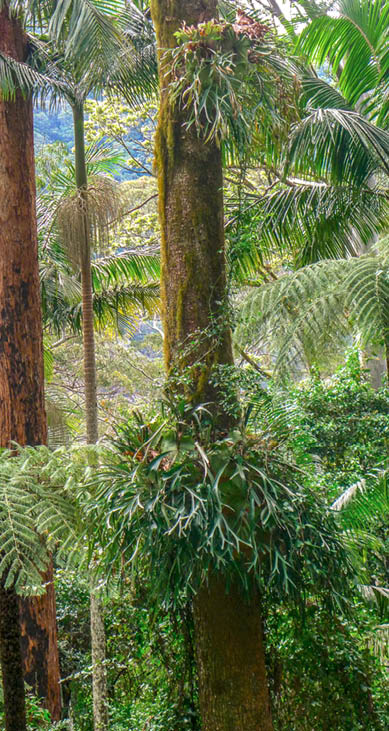
Not far from the Crags is the diversion to Anvil Rock, some of it bordered by a hanging swamp. The springtime humidity was stultifying, the static of insects incessant and, gloriously, the flowers pure bonanza:
Gibraltar waratahs were so rife I began recognising their leafy serrations.
Smoke bush, prevalent for much of the journey, but with particularly luxurious groves of it here.
Masses of the crushed white paper-like flowers of white helichrysum.
The oranges, yellows and lilacs of silky purple flag, black-eyed susan, boronia, bush pea and lemon bottle brush – post-fire, many of these are small enough to be already flowering.
Rainforest momentsA prime means of experiencing the local rainforest is the 8.5 kilometre loop of the Washpool Walk. Though being relentlessly enclosed at times, it has the paradoxical effect of enlivening rather than stifling.
It’s a ramble bursting with highlights: waterfalls, cascades, dense forest, remnants of the area’s logging past and examples of the red cedar that caused the tree-cutting frenzy. The tallest surviving red cedar is about 48 metres tall, but examples up to about 60 metres have been recorded. They are one of the few native trees to lose their leaves, their new spring copper-red leaves making them easy to spot.
The undulating route is technically interesting and, as you negotiate its reaches, replete with plenty of branch "massages":
The rainforest’s thick undergrowth ranged from the towering cedar to stands of coachwood and crabapple, along with extensive galleries of stag horns.
Fecund aromas of damp leaf mould and fungi provided complimentary nasal passage clearing.
There are sections of dry sclerophyll (which has its own eucalypt oil fragrance, no doubt some of it from the strawberry gums).
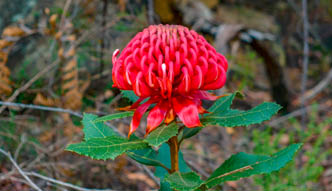
Gibraltar Waratah
Rainforest on the Washpool Walk
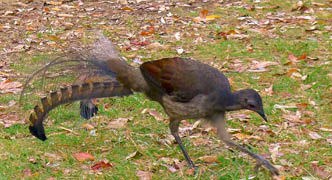
Superb lyrebird
BWA February 2021 | 17
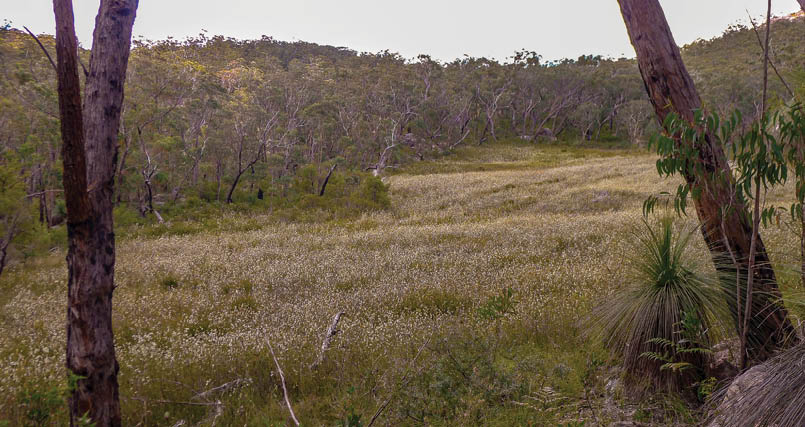
Blunt-leaf heath
Nearby, I was romanced by a superb lyrebird. It sauntered up close, doing a dainty dance while foraging for food. Pursuing it into the undergrowth, a remarkable performance occurred – sonic booms, electronic percussion-like barrages of song; bass notes thudding into my rib cage.
Coombadjha Creek is central to this location and provides several romantic settings. A highlight was following the creek upstream to the WHW’s main artery, where a wooden bridge bisects the creek. This place is thick with, and made cool and dark by, rainforest. Ferns included weeping spleenwort, king, umbrella, birds nest, felt and strap. It is a beautiful wonderland, with a large pool one of its many cossetting treats.
A Demon FaultAt Duffer Falls, another of the WHW’s diversions, a view of vastness is revealed. It reaches out over the falls’ pools and the precipitous drop to Boundary Creek, which traces the Demon Fault Line, into the deeply valleyed distance. The fault occurred about 230 million years ago, in the process breaking its rock down into weaker materials, hence expediting watercourses such as Boundary Creek scarring paths into forested ridges.
The Demon, roughly speaking, runs from the Queensland border southwards to around Dorrigo. One local outcome is that plants
and animals living either side of Boundary Creek are very different. On one side, soils are formed from old metasediment rocks. On the other, soils were formed from younger, volcanic and granite rocks that slid down the fault. On one side is a dry forest; on the other, a wet forest, the latter supporting bigger trees, more shrubs and insect-eating birds than its cross-creek rival. Koen told me the wet eucalypt forest burnt more than it has in previous fires, indicating its increasing dryness.
The civilising power of natureFor Koen, this is "proper wilderness – which is rare on this planet. I’ve done surveys at sites where there is not a single weed species. This is just about unheard of. It’s like it would have been thousands of years ago. Walking through this spectacular granite country with all the wildflowers and heath country, with its high biodiversity, is about as good as it gets.”
Whichever of the parks’ many walking options you choose, they all deliver refuge from the static of our urbanised lives. The calming and spiritually renewing forces of nature loom large. They help compensate for the emotional subsidence resulting from our interaction with urbanisation, socialisation and "civilisation" itself.
“It’s like it would have been thousands of years ago.
18 | BWA February 2021
Craig uses bushwalking to unchain the imagination and free himself from the human wrangling that accompanies corporate life in the big city. How that is consistent with his other "recreational" physical activity, that of coaching teenagers in confrontational, competitive football, remains a mystery. He’s all for stopping the production of single-use plastic bottles, and is aghast at the softening the South Coast Track and the trend of closing off sections of national parks for "premium outdoor experiences".
Nature contextualises us, giving us a perspective of the single-grain-of-sand-on-the-beach we really are. And it also provides an insight into how dependent we are on forces greater than we can control (never more societally apparent than now). The closer we get to raw nature, the more we realise how much it is incumbent on us to fight for its integrity. Not for ourselves necessarily, though any motive will do, but for our children and the future they will inherit. In this sense, nature is not just a humanising force, it is a socialising and civilising force too.
10 regional highlightsThe Gibraltar Range and Washpool National Parks are about an eight-hour drive from Sydney and a five-hour drive from Brisbane. They are located between Grafton to the east and Glen Innes to the west. After the drought and the bushfires, business was starting to pick up. Then came Covid-19. Here are 10 local businesses and activities offering unique, quality experiences. #thinklocal #supportcountry
Glen Innes Highlands Tours – guided national park tours for small to large groups. Customised to participants’ interests. Can provide bush tucker lunches. 0409 322 026.
River Sherpas – white-water canoe tours (and there is plenty of water in the rivers up this way). These occur on the 190 kilometre Clarence Canoe and Kayak Trail, which is on the Nymboida, Mann and Clarence Rivers. 0437 470 116.
Four Bull Hut – this is a gorgeous bush-bound getaway in the "Tenterfield" NW section of the Washpool NP. It makes a perfect base from which to do some trail riding. 1300 072 757.
Deepwater Brewery – craft beer and pizza; dogs allowed. What else do you need to know! 0432 757 750
The Gorge – a working cattle station featuring farm stay and camping options. Activities include canoeing (BYO gear), fishing and bushwalking. The spectacular Clarence Gorge is on the property. 02 6647 2173
Glen Innes Cottage Markets – every Saturday you can find local produce (often organically grown), arts, crafts and plants – includes donuts! 02 0403 036 328
Wild River Tours – adventure canoe and kayak tours on the Nymboida, Clarence, Macleay and Mann Rivers. Bass fishing tours are a popular speciality. 0477 779 983
Bullock Mountain Homestead – one of several farm stay options near Glen Innes. It has on-site accommodation and campsite options. Bullock Mountain has 1,200 acres of mainly rugged bushland. Activities include sapphire fossicking, fishing, yabby catching, swimming and hunting (conditions apply!). 0457 357 909
Grafton Jacaranda Season – October and November transforms Grafton’s streets so they are more purple than Prince (RIP) and, like, totes Insta-mad. Perfect time to bike through the wide country town avenues, go kayaking on the massive Clarence and witness sky-torrents of flying foxes go foraging. 02 6643 0800
Everlasting Swamp National Park – the charms of the Yuraygir coastal walk are fairly well known. Less well known is Everlasting Swamp, which has been described as "Kakadu of the south" by birdwatchers. Add cycling, walking and more waterway adventure options. What’s not to like? 02 6643 0800
For further information, contact visitor centres at Glen Innes on 02 6730 2400 and Grafton on 02 6643 0800.

BWA February 2021 | 19